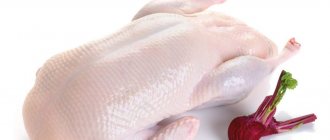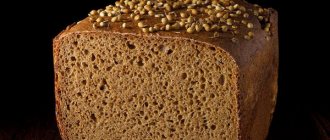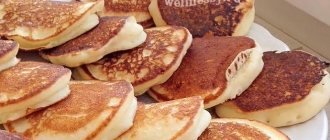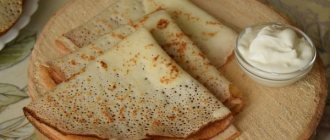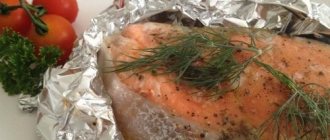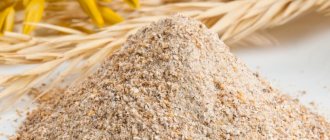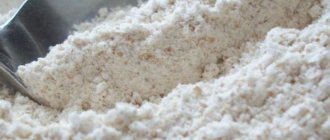By replacing the usual wheat flour with rice flour, you can add new qualities to the dish and at the same time diversify the menu. Much has been said about the benefits and harms of rice flour; the product is recommended for those who are allergic to gluten, who want to lose weight, or with digestive problems. The dishes are rich in vitamins and are easily digestible. The product is used not only in cooking, but also in cosmetology and medicine. Despite many positive reviews, there are also restrictions on use. In general, this is a safe and affordable product that has a beneficial effect on the human body.
Chemical composition of rice flour
The composition includes a large number of useful components:
- Manganese.
- Vitamins B6, E.
- Selenium.
- Niacin.
- Phosphorus.
- Magnesium.
- Copper.
- Zinc.
- Iron.
Despite the impressive list of useful elements, rice flour does not contain vitamins A and C, which are found in its wheat counterpart. We must also not forget that this is a high-calorie product. White flour contains proteins - 6 g, carbohydrates - 80 g, and fat - up to 1.5 g; in brown flour these figures are slightly higher.
Rice flour does not contain gluten; it is gluten that causes intestinal discomfort in many people. Gluten can destroy intestinal villi, interfering with the proper absorption of beneficial elements. Such a malfunction of the digestive organs can lead to:
- formation of slags;
- metabolic disorders;
- bloating;
- flatulence.
Rice flour is considered safe in this regard, as it has a minimal amount of potential allergens in its composition.
Recipe for homemade gluten-free bread in a bread machine
An easy way to make fluffy, spongy, flavorful bread is to use a bread machine.
By the way, you can make bread with pumpkin in a bread machine. Recipe with photos here!
For this we use:
- rice flour - 200 g (1 cup);
- potato starch - 200 g (1 cup);
- water - 150 ml (2/3 cup);
- kefir - 100 ml (1/2 cup);
- chicken egg - 1 piece;
- vegetable oil - 40 ml (3 tablespoons);
- instant yeast - 10 g (2 teaspoons); you can use sourdough!
- granulated sugar - 3 g (1 teaspoon).
Preparation time: 10-15 minutes.
Cooking time: 1-1.5 hours.
Total cooking time: 1.5 hours.
Quantity: loaf 0.9 kg.
Each manufacturer's bread machine operating programs are different. When kneading dough and baking, refer to the instructions for using your unit.
Baking preparation:
- Load dry and liquid ingredients according to the instructions included with the bread maker.
- Select the “Dough” mode on the control panel.
- After kneading, select the “Baking” mode, 900 g, light crust.
- After the process is completed, take out the bread and cool.
The benefits and harms of rice flour for weight loss
The rice diet is characterized by effective cleansing of the intestines, binding of excess fluid, and the absence of hunger between meals. The main thing to remember here is that it is not recommended to lose weight on rice alone. Rice flour is used at the initial stage of the diet; it is good for cleansing the body. There should not be a lot of rice components. 80 g of flour for preparing a dish is quite enough in combination with foods of moderate calorie content: eggs, vegetable puree, low-fat cottage cheese. After this, a healthy, balanced, low-carbohydrate diet begins, including protein, vegetables and fruits.
Once every six months, rice infusion is taken to cleanse the body. Leave a few tablespoons of rice flour in water, strain and drink on an empty stomach. The infusion has enveloping properties, softening contact with aggressive food components.
Useful and healing properties of rice flour
The benefits of the product are due to the content of a significant amount of vitamins, minerals and other beneficial substances.
- Has a positive effect on the proper functioning of the liver. A study published in the International Journal of Experimental Pathology reports that choline deficiency promotes liver fibrosis. Choline helps remove bad cholesterol and fats from the liver, making it a great way to ensure liver health.
- The undeniable benefits include the high level of dietary fiber, which is simply necessary for removing harmful substances from the body. Fiber also has the properties of reducing bad cholesterol and normalizing sugar levels. This may help reduce the risk of colon disease and hypertension.
- Gluten-free grinds are great for people who cannot consume gluten and people who simply want to eliminate gluten consumption. For people diagnosed with celiac disease, eating gluten will harm the immune system, so rice bread and pastries are almost the only alternative to wheat and rye.
- The copper content has a beneficial effect on the functioning of the cardiovascular system and leads to normal blood composition.
Rice flour in cosmetology
Rice, due to the presence of nutrients in it, serves to strengthen hair and nails. The benefits of rice flour for facial skin are undeniable; vitamin E helps restore firmness, elasticity, and water cellular balance. Included:
- tinctures for acne;
- tonics for tightening the skin, smoothing out unevenness;
- hair rinses;
- scrubs;
- face masks.
Included in cosmetic products belonging to the age category, it perfectly smoothes wrinkles and removes pigmentation.
Rice flour for skin: secrets of use
Cultures of various cereals, even after they have been processed in the form of grinding, contain an incredibly large amount of useful substances, from which there are benefits not only for the entire body as a whole, but also for the skin.
Rice flour is no exception to this.
China is the world's leading producer in the world. It was the first country where they began to receive and use rice flour not only for food, but also for caring for their appearance.
The nutrients included in its composition effectively tighten and smooth the skin. In this regard, it is widely used in cosmetology.
A variety of masks are prepared on its basis.
Rice flour - what is it and how is it useful?
Rice grains are the basis for producing rice flour.
They are thoroughly ground. It can be purchased in stores, or you can prepare it at home.
Its distinctive feature is that it is easily absorbed by the body.
As a result, it is widely used in baby food.
The absence of gluten in such flour determines the circumstance in which it is digested in the stomach and absorbed by the body very easily.
This is relevant for people suffering from pathologies of the digestive tract, who are prone to constipation and flatulence.
Chemical composition of rice flour
It is distinguished by the diversity of the content of various substances that have undoubted benefits for our body.
All of them are in a balanced state.
Main active ingredients:
- There is a lot of sugar in this flour. All of them are represented by mono- and disaccharides.
- It has a very rich amino acid composition. The special value of flour lies in the fact that it contains essential amino acids, which are not formed in the body, but must enter it only from the outside. It also contains a number of essential amino acids.
- The list is very diverse in its composition, which includes fatty acids of absolutely all groups. Polyunsaturated fatty acids are of particular value. They are represented by linoleic and linolenic acid. Their role for the body is simply enormous. Suffice it to say that they affect the elasticity of the vascular stack, thereby ensuring normal blood flow.
- The vitamin composition of rice flour is simply enormous. Vitamins of almost all groups are presented here. The leading role in this vitamin set belongs to vitamins, representatives of group B. The role of vitamin B 5 is to regulate all types of metabolism. As a result of a lack of pantothenic acid, damage to the skin and mucous membranes occurs. Other vitamins are also present. Nicotinic acid takes part in the processes of oxidation and reduction. Its deficiency in the body has a negative effect on the condition of the skin.
- Rice flour is rich in dietary fiber. Their role in the body for digestion is well known.
- The mineral composition of rice flour is varied and rich. It is represented by various mineral elements, the amount of which also varies. Most of all it contains manganese. Its content reaches 60%. It contains quite a lot of selenium.
- It also contains starch.
Cooking
There are a large number of recipes: pancakes, cheesecakes, dessert bread, pancakes. The dough is made with eggs and starch, since the cereal does not have binding properties. Such baked goods are quite suitable for a dietary diet. Rice flour is included in food for children, as it prevents disturbances in digestion and promotes better absorption of the product.
One of the interesting and unusual recipes is rice flour dumplings. This is a Chinese dish that requires hard work and perseverance to prepare. The dough is very fragile and breaks easily when rolling and cooking. For this reason, it is not recommended to cook rice dumplings; they are steamed.
Description of preparation:
So, I’m telling you how to make “Rice Crisps”.
They can be fried in a frying pan, like cutlets, or cooked in the oven, then the cheese will melt and the rice will be soaked in oil. The crispbreads will hold their shape perfectly and have a wonderful taste and aroma of butter and broccoli. I am for a more dietary option, so I didn’t fry anything, but baked it. To prevent the bread from sticking to the parchment, use siliconized parchment, a silicone mat, or grease the baking sheet well with oil and sprinkle with semolina. Purpose: For lunch / For dinner Main ingredient: Cereals / Rice Dish: Baking Geography of cuisine: Russian cuisine
Harm and contraindications
The product is considered virtually harmless and can be used in any diet. Allergies to rice are extremely rare. However, when using, several important points should be taken into account:
- Rice flour has a strengthening effect. For constipation and hemorrhoids, use with caution;
- It is advisable to prepare small portions, since the product is high in calories;
- If you feel unwell or feel discomfort after eating food, it is better to consult a doctor;
- The glycemic index of the product is quite high - 70 units. People suffering from diabetes are better off avoiding dishes made from rice flour.
Both the advantages and disadvantages of rice flour are associated with the lack of the plant protein gluten. Recently, the demand for the product has increased; many people include it in their diet, striving for a healthy diet and cleansing the body.
How the composition and benefits of rice flour are related
Rice flour is made from various varieties of rice, but it is all divided into two categories:
• white, from polished snow-white rice;
• dark in color, made from brown rice.
The second variety, otherwise called whole grain, is slightly less popular than the first, but is considered healthier, since for it the grains are first cleaned only from the thin outer shell.
White rice flour is neutral in taste and does not interfere with the flavor and aroma of other products. Whole grain has a more pronounced taste with a slight nutty note.
This extraordinary flour is an indispensable ingredient in the cuisines of China, Southeast Asia and Japan. It is used to prepare translucent noodles, dim sum, pancakes for the famous Peking duck, and baked bread and baked goods. They make rice paper, which is in demand for spring rolls and for creating color edible printing of designs on cakes. Flour is used to thicken yogurts, soups, cereals, sauces and breading.
Baking made from rice flour has a porous crumb and a crispy crust, but in most recipes it is necessary to add wheat flour to the rice flour (at least 25% of the total volume), otherwise everything will not bake well, and the yeast dough will not rise at all. Rice flour requires an increase (compared to wheat) in the proportions of water and eggs in dough recipes, because it absorbs moisture very well
Rice flour requires an increase (compared to wheat flour) in dough recipes in the proportions of water and eggs, because it absorbs moisture very well.
It is also combined with oatmeal, corn, buckwheat, nut flour, in a word - any kind.
To prevent the quality of the products from deteriorating, old rice flour is never mixed with fresh flour.
Rice flour is produced both according to GOST (used to produce baby food - vegetable and meat purees) and according to specifications (sold in stores, in demand for the manufacture of various products).
It will not be possible to prepare rice flour at home - you will be able to do nothing more than grind the grain thoroughly, but that same powdery structure can only be achieved in industrial conditions.
The shelf life of rice flour is no more than six months, always in a dark, dry and cool place. It is better in a container with a tight-fitting lid, since the taste of this flour deteriorates over time due to air access.
Rice flour has a unique composition. It contains amino acids and minerals, especially high in manganese, selenium, phosphorus, copper, zinc, and potassium.
But its main feature is the complete absence of gluten. On the one hand, the absence of gluten does not allow much to be baked from it without adding wheat flour. But on the other hand, this makes it an indispensable product for those who are forced to avoid gluten due to allergies.
Rice flour contains a large amount of starch, which adds to its importance for the diet of fans of a healthy lifestyle and sports.
Its energy value is about 360 kcal per 100 g, of which up to 80% comes from carbohydrates and only 6% from proteins. But a small amount of rice proteins is also valuable - they are involved in the construction of new cells.
This same portion provides 12% of an adult’s daily requirement for dietary fiber. Rice fiber has an absorbent effect - it absorbs toxins, heavy metal salts, undigested food residues and removes all this from the body, simultaneously gently stimulating intestinal activity, thereby improving metabolism.
Dishes made from rice flour are easily digestible and put minimal strain on the digestive system.
The consumption of rice flour is not contraindicated even in case of chronic enterocolitis and gastric ulcer.
Dishes made from rice flour are very filling. So good that they reduce the body’s need (and the need that arises purely psychologically) to enjoy something tasty and sweet, or fatty.
Reviews
Mochenkov Vladimir Ivanovich, 48 years old, Novosibirsk All his life he suffered from gluten intolerance, so he had to limit himself in food. Recently my daughter talked about milled rice and its benefits for people with celiac disease. Now my wife bakes bread, makes homemade noodles and other dishes, which have significantly diversified my diet and made it possible to lead a full life. And my sister says that she washes her hair with rice flour and uses it instead of powder. So the benefits of the properties of this product are very great. But I haven’t heard anything about the harm yet. Talyzina Elizaveta Yaroslavovna, 23 years old, Tomsk To get rid of freckles, I tried many different remedies: I bought them in pharmacies, I did them myself, but the result was zero. And a face mask made from rice flour helped: in just a month, the freckles disappeared without harm to the skin, and the face became cleaner and brighter. I heard that rice flour is effective not only in cosmetology, but also for hair and weight loss. A very useful tool! Did you find this article useful? Not really
Energy value
Rice flour is snow-white, soft, powdery. It has no taste or smell.
100 grams of rice flour contains:
- carbohydrates - 80 grams;
- proteins - 5.9 grams;
- fat - 1.42 grams;
- water - 11 grams;
- dietary fiber - 2.4 grams.
Rice flour, which has 366 kilocalories per 100 grams, consists of 80 percent starch and does not contain gluten. It is an ideal gluten-free product.
Corn flour
Corn flour is a very healthy product. It, like rye, is suitable for diabetics, but unlike rye, corn flour will not harm people with digestive problems. The only thing worth paying attention to is the property of corn flour to thicken the blood, so people who have problems with blood vessels should not get carried away with baking from this flour. But for those who are allergic to gluten, corn flour is not dangerous.
Corn flour is suitable for many dishes. You can use it to cook porridge, polenta and hominy, bake tortillas and bread, make chips and tortillas. Many national cuisines contain dishes made from corn flour, even in our country - zagora non, corn flatbread, or bulamik - corn porridge with meat.
For baking, you need to mix corn flour with wheat flour in a 1:1 ratio.
The calorie content of corn flour is 330 kcal per 100 grams.
In the Shedevr supermarket, 900 grams of corn flour costs 3,990 soum.
In “Korzinka” on Rakat, 900 grams of corn flour costs 3,490 soum.


